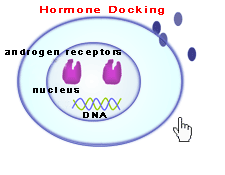Endocrine Disruption
|
Actions : Docking :: Receptor Binding Nuclear Receptors Trigger Gene Expression All nuclear receptors (receptors found in the cell’s nucleus and cytoplasm), whether they bind to hormones or to other kinds of ligands, are transcription factors. That is, they are proteins that regulate gene expression by attaching to the promoter region of a gene and inhibiting or stimulating gene transcription. Transcription is a process where a piece of DNA is used as a template to make a complimentary RNA strand - called a messenger RNA - that transmits genetic commands from the nucleus to other parts of the cell. With hormone signaling, the entire gene expression effort, and subsequent protein synthesis, depends on the hormone receptor. Before binding to hormones, nuclear hormone receptors are linked to chaperone proteins. The quiescent androgen, progestin, glucocorticoid, and mineralocorticoid receptors reside in the cytoplasm while estrogen receptors are found in the cytoplasm and the nucleus. When a hormone binds to a receptor, the activated receptor disconnects from the chaperone protein and partners with another hormone-bound receptor to form a dimer. Dimers in the cytoplasm then move into the nucleus where the DNA is located. In the nucleus, the activated hormone receptor pairs attach to the hormone response element, which is a specific sequence of DNA located in the promoter region of the target gene. The attached receptor is the primary transcription factor, serving as the foundation where all the other transcription factors anchor. Once in place, the receptor initiates gene transcription by interacting with other transcription factors, such as TFIIA, TFIIB, and many others. Generally, many different transcription factors pile onto the attached hormone receptor at the same time. One group of transcription factors helps unwind the DNA making it accessible to the enzyme RNA polymerase. A second group of transcription factors then recruits RNA polymerase to join the stack. This sparks gene transcription - RNA polymerase uses a DNA template to make messenger RNA (mRNA) - followed by translation - the ribosomes in the cytoplasm build a protein by reading mRNA's code and recruiting transfer RNA (tRNA) to supply the protein's amino acid building blocks.
An example is shown in the animation above. When the androgen hormone testosterone (blue) binds to an androgen receptor (purple) in the cytoplasm, the receptor leaves the chaperone protein (green) and pairs with another activated androgen receptor to form a dimer. The dimer moves to the nucleus where it binds to the DNA and interacts with other transcription factors (multiple colors). This molecular huddle promotes DNA unraveling, exposing the appropriate DNA template used to make new mRNA that will carry a genetic message to the cytoplasm where ribosomes assemble the proteins during translation. back to top |
